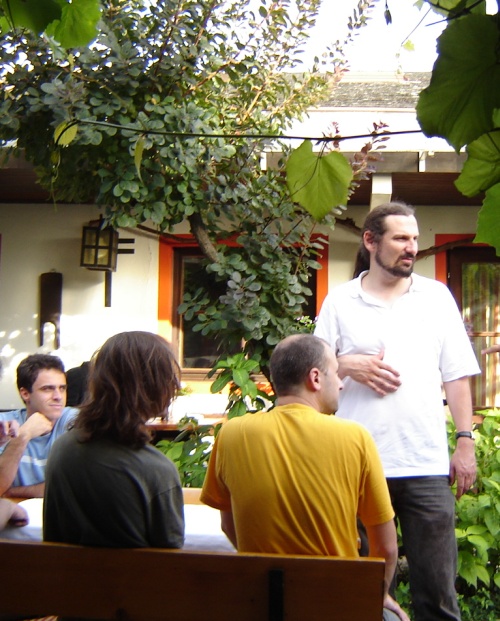I am wondering about that business of integration of Lie -algebroids.
For the record, I’ll first recall how it works for . Then I remark on the higher -case (in the form of a question).
Integrating Lie 1-Algebroids
I haven’t tried to check who first came up with this, but here is the standard way to integrate a Lie 1-algebroid to a Lie groupoid:
Let be the interval, let denote the Lie algebroid of its pair groupoid (the tangent algebroid) and let denote the Lie 1-algebroid in question to be integrated.
Then, we first build a Lie 2-groupoid as follows:
its space of objects is the space underlying .
a morphism in is a morphism of Lie algebroids
composition is the obvious one induced by the (by any) diffeomorphism
(this is associative only up to 2-morphisms!)
for the standard bigon (square with vertical edges shrunk to a point) a 2-isomorphism in between two paths as above exists if there is an algebroid morphism
which restricts to the given paths on top and bottom, respectively.
Source and target are the obvious ones. Composition in various directions comes from the obvious composition of the standard bigon.
The point then is, which John is alluding to in his TWF above:
we can in general imagine diving out 2-isomorphisms in , in order to be left with a mere 1-groupoid. But in some cases it may happen that this quotient is no loger sufficiently well behaved (not a manifold, in particular). So in some cases this leaves us with a 2-groupoid. Or a stacky 1-groupoid. Or things like that.
Notice how this method sneakily captures the ordinary integration of a Lie algebra to a Lie group:
let be a Lie 1-algebroid over a point, hence a Lie algebra . Then a Lie algebroid morphism
is nothing but a -valued 1-form on .
When I first learned about this, I was confused by the fact that this morphism itself is now already regarded as a representative of a group element. No path “ordered exponential” is involved!
The trick is this: by the nonabelian Stokes’ theorem, the identitfication of two such elements via an interpolating morphism
says precisely that two such 1-forms on the interval are identified if there is a flat -connection on the disk interpolating between them. But Stokes’s theorem says that precisely in this case do the path ordered exponentials of the given 1-forms coincide!
So these exponentials don’t appear explicitly, but the equivalence relation is exactly such that they would be respected had we computed them.
In a way this method is very close to my heart: it says in effect that every Lie groupoid is best thought of as the image of a parallel transport.
Generalization to higher
I know what Lie -algebroids are. I know what morphisms of them are. I know how to generalize all the above constructions accordingly. It’s pretty obvious.
It seems that the only issue one runs into is: one needs to fix some notion of weak -groupoid.
(If we restrict to Lie -algebroids coming from “NQ”-manifolds then it even suffices to assume that we have strict inverses in the Lie -groupoid, I think. Only associativity will be weakened.)
For instance, I’d be surprised if for any Lie 2-algebroid, the obvious generalization of the above procedure wouldn’t yield a tricategory. Of course one would have to check.
In any cas,e it seems that the globular model is the best suited one. If I were to ask about a nice globular model for weak -groupoids with strict inverses. What would you point me to?
again
And then, I am of course wondering about this: since I am claiming that instead of worrying about any old Lie -algebroid , we really mostly just want to be looking at the Lie -algebroid :
is there any chance that in this case we never run into the issue of quotients failing to be smooth?
That might actually be an “explanation” of that funny shift in dimension.




Who’s behind that final quote? Re: This Week’s Finds in Mathematical Physics (Week 256)
I usually believe (depends on mood and setting and company present) that Scientists are studying a single real universe, by various imperfect means.
Mathematicians, on the other hand, are doing something. But Philosphers of mathematics have not been able to answer the question cited by Corfield: “How do mathematicians steer their careers?”
That’s a puzzle, because they do not have feedback from “nature” the way scientists believe they have.
Here’s an intriguing quotation at the ned of the Week 2^8 blog by John Baez:
“Viewed superficially, mathematics is the result of centuries of effort by thousands of largely unconnected individuals scattered across continents, centuries and millennia. However the internal logic of its development much more closely resembles the work of a single intellect developing its thought in a continuous and systematics way - much as in an orchestra playing a symphony written by some composer the theme moves from one instrument to another, so that as soon as one performer is forced to cut short his part, it is taken up by another player, who continues with due attention to the score.”
- I. R. Shavarevich
Only who is that? Is it an alternate spelling, as Google hints to me?
In mathematics, the Golod-Shafarevich Theorem, named after the two Russian mathematicians Evgeny Golod and Igor Shafarevich, who proved it on 1964 is an important theorem in combinatorial group theory. In its most basic form, it states that if G is a finite p-group with minimal number of generators d and has r relators in a given presentation, then
r > (d^2)/4.
References
1. Johnson, D.L. (1980). Topics in the Theory of Group Presentations (1st ed.). Cambridge University Press. ISBN 0-521-23108-6. See chapter VI.
Or is it a Socialist mathematician and writer (as the strange valorization of the collective over the individual suggests) as Wikipedia begins:
Igor Rostislavovich Shafarevich (Russian: Игорь Ростиславович Шафаревич, born June 3, 1923 in Zhytomyr) is a Russian mathematician, founder of the major school of algebraic number theory and algebraic geometry in the USSR, and a political writer. He was also an important dissident figure under the Soviet regime, a public supporter of Andrei Sakharov’s Human Rights Committee from 1970. He supported the criticisms of Alexandr Solzhenitsyn of both Soviet communism and liberal proposals for the future of Russia.
Shafarevich’s 1970s book The Socialist Phenomenon was widely circulated in the West. After the Cold War, he attacked those he called “small people,” who deny the “historical achievements” of Russia, saying his homeland must have “sound democratic statehood, based on the will of the people.” His critics call him a radical, anti-Semitic, Christian nationalist.
Shafarevich’s contribution to mathematics include the theory of the Tate-Shafarevich group (usually called ‘Sha’, written ‘Ш’, his Cyrillic initial) in Galois cohomology, and the Golod-Shafarevich theorem on class field towers. He initiated a Moscow seminar on classification of algebraic surfaces that updated around 1960 the treatment of birational geometry, and was largely responsible for the early introduction of the scheme theory approach to algebraic geometry in the Soviet school.
Shafarevich was a student of Boris Delone, and his students included Evgeny Golod, S.Y. Arakelov, I.A. Kostrikin and Yuri Manin. In view of later accusations of anti-Semitism on his part, it can be noted that his research students included some identified as Jewish, and that later, during his most serious troubles in the 1970s with the Soviet authorities, he did major work in collaboration with Ilya Piatetski-Shapiro on K3 surfaces. He is a member of the Serbian Academy of Sciences and Arts in department of Mathematics, Physics and Geo Sciences.
On his 80th birthday, Russian President Vladimir Putin hailed his “fundamental research” in mathematics and his creation of “a large scientific school that is known both in Russia and abroad.
Hmmm. I’m not a big fan of Putin, or anti-Semites. However, I have read and enjoyed a lot by Sakharov and Solzhenitsyn. And the Tate-Shafarevich group is cool, and I more than half understood it after hours of effort…